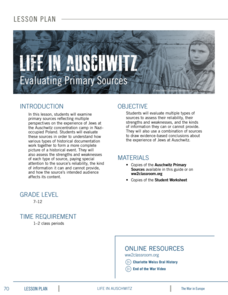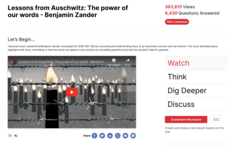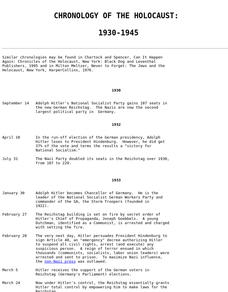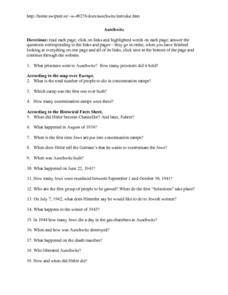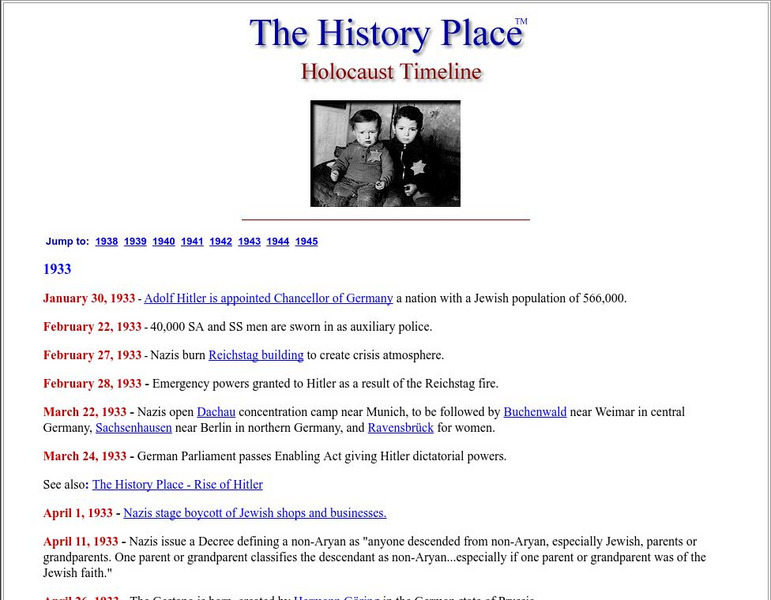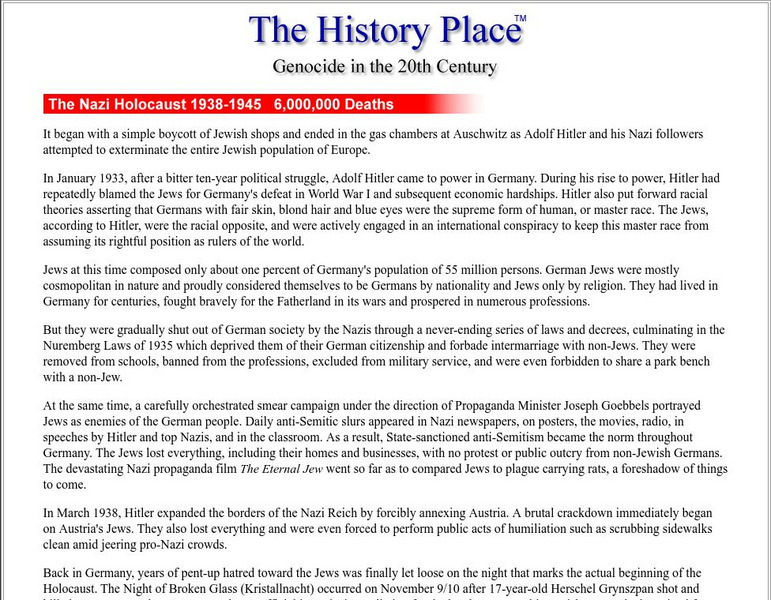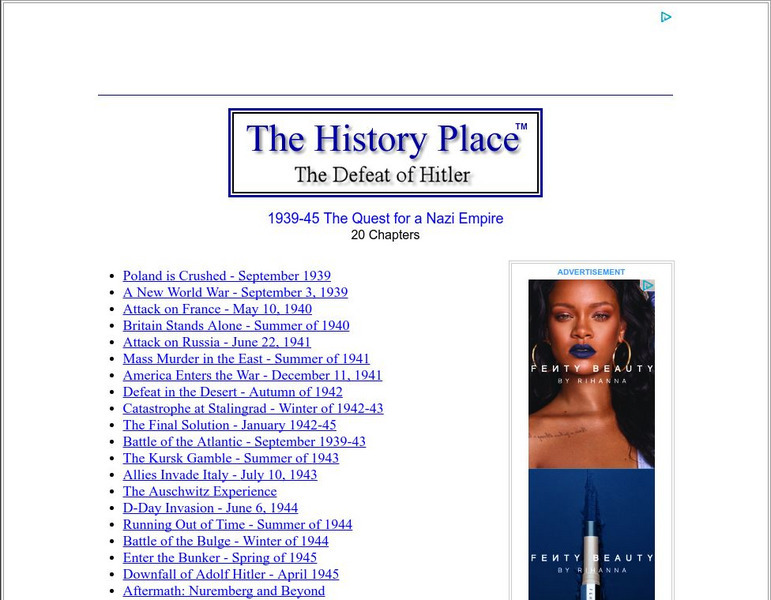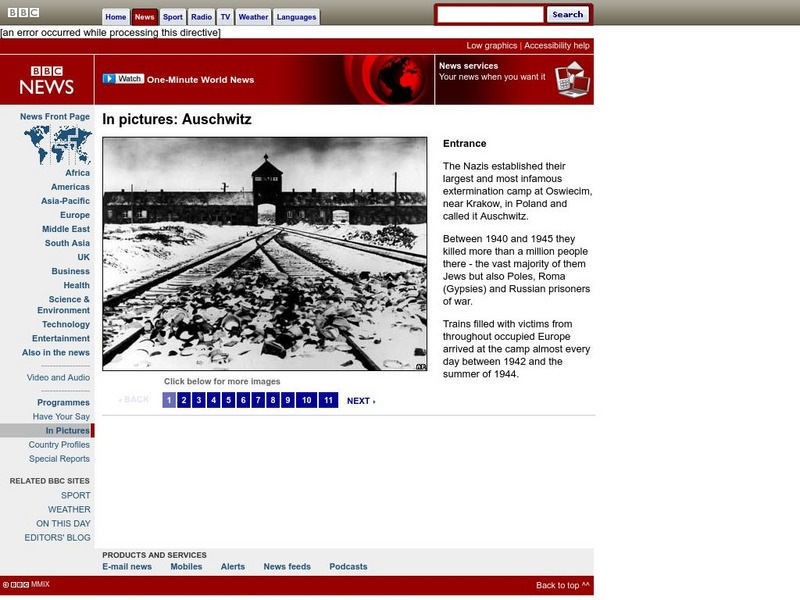National WWII Museum
Life in Auschwitz: Evaluating Primary Sources
Historians explain what happened during the Holocaust, but only primary sources portray the true horror of places such as Auschwitz. Using accounts from those who survived the camps, as well as a Nazi government official's memoirs, class...
US National Archives
Eastern Europe 1939-45 — Camps
Britain's decision not to bomb German death camps in World War II has provided many questions for historians, but with a primary source analysis lesson, high school students may be a step closer to finding out the truth. Learners read...
Reed Novel Studies
The Boy in the Striped Pajamas Film Study
According to John Betjeman, "Childhood is measured out by sounds and smells and sights, before the dark hour of reason grows." With The Boy in the Striped Pajamas film study, scholars work in small groups to discuss the quote and other...
TED-Ed
Lessons from Auschwitz: The Power of Our Words
Some words are best left unspoken. Words matter, according to Benjamin Zander, conductor, teacher, and lecturer. To illustrate his point, Zander recounts a story told to him by a survivor of Auschwitz. As a result of her experience this...
Curated OER
A Chronology of the Holocaust
A straightforward chronology of the Holocaust lists events from 1930 to 1945. Connects to a page with links to extensive resources and information about the Holocaust. Use as a resource for student inquiry into the Holocaust.
Curated OER
Night: Guided Imagery Activity
Prior to reading Night, class members engage in a guided imagery activity that helps them make text-to-self connections to Elie Wiesel’s account of his experiences with his father in Auschwitz and Buchenwald. Complete directions, as well...
Curated OER
Lessons from the Holocaust
Students prepare a reaction statement about what they read. In this Holocaust lesson students read several personal accounts from the Holocaust. The students answer a series of questions related to the Nazis and their concentration camps.
Curated OER
Auschwitz Episode Guide: Surprising Beginnings
Students examine how the Nazis came to power and living conditions at Auschwitz. They watch and discuss a PBS documentary, read and discuss handouts, analyze a Pyramid of Hate, and assign experiences in their own lives to different...
Curated OER
Conversations With The Past
Students consider what they already know about the Holocaust and reflect on the sixtieth commemoration of the liberation of Auschwitz by reading and responding to testimonials of victims. They create artwork to honor those who...
Curated OER
Nazi Concentration Camps -- Map and Chart-Reading Activities
Learners use an informational chart about Nazi concentration and death camps to complete a mapping activity and a chart-reading activity.
Curated OER
Diaries From the Holocaust
Sixth graders find similarities and differences in two different diary entries. In this Holocaust history meets literary skills lesson, 6th graders read the diary of a soldier or prisoner from the the Auschwitz concentration camp and...
Curated OER
Auschwitz
In the Auschwitz worksheet, pupils respond to 36 short answer questions as they visit and research websites pertaining to the infamous concentration camp of World War II.
Curated OER
Auschwitz Episode Guide: Corruption
High schoolers examine life at the Auschwitz concentration camp. They watch and discuss a PBS documentary, analyze reasons for prosecuting perpetrators after the war, and develop criteria for recognizing Internet sites developed by...
Curated OER
Auschwitz Episode Guide: Factories of Death
Students examine Hitler's "Final Solution." They watch and discuss a PBS documentary, read handouts, conduct Internet research, and read and discuss a personal memoir.
Curated OER
Resistance during the Holocaust
Students define and discuss resistance and distinguish types of resistance, watch video Courage to Care, research partisans and identify their main objective, and research facts behind proposed Auschwitz bombing and White Rose Resistance.
US Holocaust Memorial Museum
U.s. Holocaust Memorial Museum: Auschwitz Through Lens of the Ss
A moving online exhibit of photographs from an album of a Nazi officer who was the commandant at Auschwitz. The accompanying commentary includes a video, podcast, and comparison of the photos of Nazi officials to those of the inhabitants...
The History Place
The History Place: Holocaust Timeline
This site is a chronology of the events between January 30, 1933 when Hitler became Chancellor and, and the year 1961 when Eichmann was on trial in Jerusalem. There are many useful links that connect you with pictures and photos.
The History Place
The History Place: The Nazi Holocaust 1938 1945
Article depicting the Nazi Holocaust from the beginning in 1938 with a simple boycott to the end in 1945 with the liberation of the death camps.
The History Place
The History Place: The Defeat of Hitler: 1939 1945: Quest for a Nazi Empire
A 20-chapter book on the history of Nazi Germany over the course of the Second World War.
PBS
Elie Wiesel: First Person Singular . Teaching Guide | Pbs
In this unit, students will learn about the Holocaust through the point of view of the Nobel Laureate and Holocaust survivor, Elie Wiesel. The accompanying teaching guide includes activities related to self-reflection, listening, and...
Yad Vashem, The World Holocaust Remembrance Center
Yad Vashem: And These Are Their Names
A mass grave in Poland holds the remains of 45 victims of the Death March from Auschwitz. Yad Vashem works diligently to identify the remains and provide a proper gravestone. So far, 16 have been identified and you can read their stories...
University of South Florida
Fcit: A Teacher's Guide to the Holocaust
A Teacher's Guide to the Holocaust offers an overview of the people and events of the Holocaust. Extensive teacher resources and student activities are included, as well as photographs, documents, art, music, movies, literature, and more.
US Holocaust Memorial Museum
U.s. Holocaust Memorial Museum: Holocaust History Animated Maps
To fully understand the breadth and scope of the Holocaust, view the following maps of key locations. These maps are in video form with explanations provided. There are also links provided for further research.


